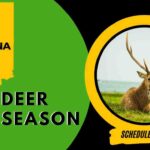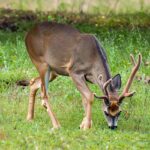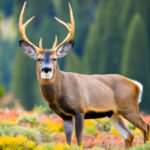For many, the thrill of the hunt is synonymous with the pursuit of deer. These elusive ungulates, with their keen senses and cautious nature, have captivated hunters for centuries. But mastering the art of deer hunting requires more than just a rifle and a good pair of boots. It demands knowledge, skill, and a deep respect for the natural world.
This comprehensive guide is your one-stop resource for everything you need to become a successful deer hunter. From deer behavior and equipment selection to hunting methods and ethics, we’ll give you the skills and confidence to hunt with purpose.
1. Know Your Quarry: Understanding Deer Behavior
Before venturing into the woods, it’s crucial to understand your target. Deer are intelligent and adaptable herbivores, their behavior dictated by seasonal changes, food availability, and breeding cycles.
Seasonal Shifts:
- Spring: Deer emerge from winter with depleted energy reserves, focusing on foraging and replenishing their bodies.
- Summer: Bucks focus on antler growth, while does prepare for fawning. Deer activity generally decreases in the heat of the day.
- Fall: The rut, or breeding season, arrives, driving dramatic behavioral shifts as bucks compete for mates.
- Winter: Deer prioritize energy conservation, seeking shelter and high-calorie food sources.
Habitat and Activity Patterns:
- Deer prefer areas with a mix of cover and open spaces, offering both feeding opportunities and protection.
- They are most active at dawn and dusk, with limited movement during the midday heat.
- Understanding deer trails, bedding areas, and feeding grounds is essential for successful hunting.
| Season | Key Behavioral Characteristics | Hunting Tips |
|---|---|---|
| Spring | Regaining energy, foraging, antler growth | Focus on food sources and bedding areas, use calls and decoys to attract bucks during pre-rut. |
| Summer | Antler growth, fawning, reduced activity in heat | Target feeding areas in early mornings and evenings, scout for does and fawns in known bedding areas. |
| Fall | Rutting season, increased activity and aggression | Utilize vocalizations and decoys effectively, hunt near trails and scrapes, be prepared for unpredictable behavior. |
| Winter | Conserving energy, seeking shelter and food | Focus on areas with high-calorie food sources like mast and agricultural fields, hunt during warm spells when deer are more active. |
2. Gear Up for Success: Essential Deer Hunting Equipment
The appropriate gear may improve your hunting considerably and raise your chances of success. Here are some key considerations:
Firearms and Optics:
- Choose a rifle or bow suitable for your preferred hunting style and terrain.
- Invest in a high-quality scope with appropriate magnification for ethical shot placement.
Clothing and Camouflage:
- Opt for comfortable, weather-appropriate clothing that blends seamlessly with your environment.
- To be flexible in response to changing weather, layer your clothes.
Scent Control and Decoys:
- Minimize your scent through proper field hygiene and specialized odor-masking products.
- Decoys can attract curious deer, offering valuable hunting opportunities.
Additional Gear:
- A reliable backpack to carry essential supplies like binoculars, rangefinders, first-aid kits, and knives.
- Sturdy boots for traversing uneven terrain and staying silent.
- A comfortable and portable hunting seat for long periods of waiting.
3. Mastering the Hunt: Essential Techniques and Strategies
With your knowledge and equipment in place, it’s time to hone your hunting skills. Here are some fundamental techniques to refine your approach:
Scouting and Stand Placement:
- Thoroughly scout your hunting area, identifying deer trails, bedding areas, and feeding grounds.
- Position your hunting stand strategically downwind of deer hotspots, ensuring adequate cover and concealment.
Stalking and Still Hunting:
- Master the art of silent movement, using natural cover and wind direction to your advantage.
- Practice still hunting, remaining motionless for extended periods to attract curious deer.
Calling and Decoying:
- Learn to use deer calls effectively, mimicking natural sounds to entice deer closer.
- Utilize decoys strategically to pique the curiosity of bucks, especially during the rut.
Shot Placement and Ethical Considerations:
- Always prioritize ethical hunting practices, ensuring responsible harvesting and minimizing suffering.
- Understand vital anatomy and practice shot placement for quick and humane kills.
| Gear Category | Essential Items | Considerations |
|---|---|---|
| Firearms and Optics | Rifle or bow, scope, ammunition or broadheads | Choose based on hunting style and terrain, ensure proper maintenance and practice for accuracy. |
| Clothing and Camouflage | Hunting suit, boots, gloves, hat | Select for weather conditions and terrain, prioritize camouflage patterns that blend with the environment. |
| Scent Control | Scent-eliminating sprays, washes, clothes, ozone generators | Minimize human odor through proper hygiene and specialized products, consider wind direction when hunting. |
| Optics | Binoculars, rangefinder | Essential for scouting, spotting deer, and determining distances for ethical shot placement. |
| Hunting Packs | Backpack or day pack | Carry essential gear, snacks, water, and first-aid supplies comfortably. |
| Knives | Hunting knife, gut hook | Used for field dressing, processing meat, and other tasks. |
| Safety Gear | First-aid kit, compass, whistle, emergency shelter | Prepare for unexpected situations and ensure safe hunting practices. |
4. Beyond the Harvest: Respect and Conservation
Deer hunting is about much more than simply filling a tag. It’s a responsibility that demands respect for the animal, the land, and the ethical principles of responsible wildlife management.
Respecting the Quarry:
- Always approach the harvest with respect and gratitude, acknowledging the life taken and the vital role deer play in the ecosystem.
- Minimize waste by utilizing all edible portions of the deer and practicing proper field dressing techniques.
Conservation and Stewardship:
- Support ethical hunting organizations and initiatives that promote responsible deer management and habitat conservation.
- Be a responsible steward of the land, minimizing your impact on the environment and leaving no trace behind.
Ethical Hunting Practices:
- Adhere to all local hunting regulations and laws, ensuring you are operating within legal boundaries.
- Never take more than your fair share or engage in unethical practices like baiting or poaching.
| Ethical Principle | Description | Importance |
|---|---|---|
| Respect for the animal | Humane treatment, responsible shot placement, proper field dressing | Minimize suffering, honor the life taken, and ensure proper utilization of the animal. |
| Adherence to regulations | Following hunting laws, bag limits, and season restrictions | Protect deer populations, maintain sustainable hunting practices, and ensure compliance with legal requirements. |
| Conservation and stewardship | Supporting habitat conservation, responsible land management, and ethical hunting organizations | Ensure the long-term health of deer populations and their habitats. |
| Minimizing impact | Leaving no trace, avoiding pollution, and respecting other wildlife | Protect the environment and maintain a positive image of hunters. |
5. Continuous Learning and Improvement:
The journey to becoming a successful deer hunter is a continuous learning process. Don’t be afraid to experiment, try new techniques, and seek guidance from experienced hunters.
Seek Mentorship:
- Connect with seasoned hunters who can share their knowledge and experience, offering valuable insights and feedback. Consider joining hunting clubs or attending workshops to learn from others.
Embrace Field Research:
- Immerse yourself in the field, observing deer behavior, studying tracks and signs, and honing your scouting skills. Every hunt, successful or not, offers valuable lessons and opportunities for growth.
Utilize Resources:
- Leverage readily available resources like hunting magazines, online forums, and educational videos to expand your knowledge base and stay updated on new techniques and advancements.
Practice Ethical and responsible Hunting:
- Always prioritize safety and ethical practices in the field. Respect other hunters, landowners, and game wardens, and contribute to the responsible management of deer populations.
Remember, Successful deer hunting is about more than just bringing home a trophy. It’s about cultivating a deep understanding and respect for the natural world, embracing ethical practices, and constantly honing your skills and knowledge. By approaching the sport with dedication, patience, and a lifelong commitment to learning, you can not only experience the thrill of the hunt but also become a responsible steward of the environment and contribute to the future of this magnificent species.
6. Beyond the Guide: Further Resources
This guide has equipped you with the fundamentals of successful deer hunting. However, the learning journey never truly ends. Here are some resources to delve deeper into specific aspects and continue your growth as a skilled and responsible hunter:
- Whitetail Deer: Biology, Management, and Conservation by David Guynn: A comprehensive and scientifically grounded resource covering deer biology, habitat, and management practices.
- The Book of the Deer by Jack O’Connor: A classic hunting memoir by a legendary outdoorsman, offering timeless wisdom and insights into the pursuit of whitetail deer.
- National Deer Association’s website: A treasure trove of information on deer biology, hunting techniques, ethics, and conservation initiatives.
- Local hunting clubs and organizations: Connect with fellow hunters in your area to share experiences, learn from each other, and engage in responsible hunting practices.
Remember, the field of deer hunting is vast and ever-evolving. Embrace the continuous learning process, seek new knowledge, and most importantly, respect the incredible animal you choose to pursue. With dedication and a commitment to ethical practices, you can become a successful and responsible hunter, leaving a positive impact on the world of deer and the natural world we all share.
Conclusion:
The thrill of the hunt, the quiet anticipation in the pre-dawn woods, the connection to nature – these are just a few of the reasons why deer hunting continues to captivate generations of hunters. By equipping yourself with knowledge, skill, and respect, you can navigate the field with confidence and become a responsible steward of the land and its majestic inhabitants. So, grab your gear, embrace the learning process, and embark on your own deer hunting adventure. The whispering woods await, and the memories you create will resonate long after the echoes of your shot fade away.
FAQ
What’s the best caliber for deer hunting?
There’s no one-size-fits-all answer, as the ideal caliber depends on factors like game species, range, terrain, and personal preference. Popular choices for deer hunting include .270 Winchester, .30-06 Springfield, and .308 Winchester, offering a good balance of power, accuracy, and recoil. Consult a gunsmith or experienced hunter for guidance based on your specific needs and experience level.
What is the best time of year to go deer hunting?
What are the essential pieces of gear for a beginner deer hunter?
- California Deer Hunting Guide: Seasons, Rules, Permits, and More - 26 June 2024
- Arkansas Deer Season 2024 [Schedules, Licenses, Bag Limits & More!] - 26 June 2024
- 2024 Arizona Deer Season New Dates & Rules! - 25 June 2024




